Public Art Projects Move Forward
Ann Arbor public art commission special meeting (March 7, 2013): Because attendance was low at AAPAC’s regular meeting in late February, commissioners held a special meeting the following week to wrap up items that hadn’t been addressed.
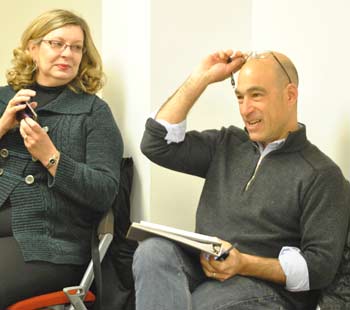
Bob Miller, right, is the new chair of the Ann Arbor public art commission. To the left is Deb Polich, executive director of the nonprofit Arts Alliance. They were attending the March 15 meeting of the city council’s public art committee, which is developing revisions to the city’s public art ordinance. (Photos by the writer.)
Commissioners voted to accept a memorial for Coleman Jewett as an official AAPAC project and to approve Sarah Gay as a volunteer project manager. Her duties would be to lead efforts for city council approval, donor relations and fundraising. John Kotarski advocated for less involvement from AAPAC, saying he hoped to streamline the project.
However, other commissioners felt it should be handled like other projects, with oversight by AAPAC. The proposal is for a bronze Adirondack chair at the Ann Arbor farmers market. The city’s market manager, Sarah DeWitt, attended the March 7 meeting and will help coordinate the project.
Commissioners also voted to increase the honorariums for artists who have been selected as finalists for a $400,000 project at the East Stadium bridge. The overall project amount remains unchanged, but honorariums were raised from $2,000 to $3,000 for each of the four finalists: Volkan Alkanoglu, based in Atlanta, Georgia; Sheila Klein of Bow, Washington; Rebar Group of San Francisco; and Catherine Widgery of Cambridge, Mass. They will be in town on April 1 for a site visit and public open house.
Another effort that’s in the early phases got a vote of support from commissioners, but no financial commitment at this point. The project will use old aluminum canoes from the city of Ann Arbor’s Argo canoe livery, which artists and community groups will turn into artwork that will be displayed throughout the downtown in 2014. Partners in the project include the Ann Arbor Area Convention & Visitors Bureau (CVB), the Main Street Area Association (MSAA), the Arts Alliance, and the Huron River Watershed Council. AAPAC is involved only in a supportive role, to help with public engagement.
The role of public engagement was part of a discussion regarding AAPAC’s annual public art plan, which is due to the city council on April 1. Some commissioners expressed frustration at the process, given the uncertainty of the public art program’s future. Ultimately, they gave guidance to Aaron Seagraves, the city’s public art administrator, to draft a plan that includes projects in highly-visible, highly-used locations, currently underserved in terms of public art.
The March 7 meeting also included the election of officers. Bob Miller was elected the new chair, replacing Marsha Chamberlin. Kotarski abstained from voting. He noted that the commission will soon be at only 40% capacity – a reference to the fact that there are three vacancies on the nine-member commission, with an additional resignation expected by Wiltrud Simbuerger in the near future.
Two of those vacancies will likely be filled shortly. Nominations are on the city council’s March 18 agenda for confirmation: Nick Zagar, an artist and commercial real estate agent who serves on the Ann Arbor Art Center board; and Ashlee Arder, programs coordinator at ArtServe Michigan.
All of these actions come in the context of the city council’s ongoing review of the city’s public art program, which began in early December of 2012. This article begins with a report on the most recent meeting of the council’s public art committee on Friday, March 15. An update of their work will be attached to the council’s March 18 agenda as an item of communication. Their next committee meeting is scheduled for March 28.
Revisions to Public Art Program
A five-member city council committee has been meeting since December 2012 to develop recommendations for the city’s public art program and possible revisions to two city ordinances that affect that program – Chapter 8 (organization of boards and commissions) and Chapter 24 (public art).
The work traces back to Dec. 3, 2012, when the city council voted to halt the spending of funds accumulated through Ann Arbor’s Percent for Art program, except for projects that are already underway. Unless extended by the council, the moratorium on spending lasts until April 1, 2013.
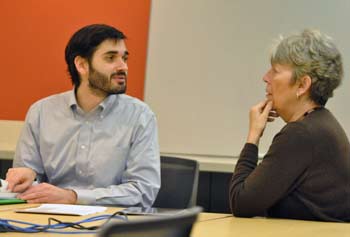
Assistant city attorney Christopher Frost and Marsha Chamberlin of the Ann Arbor public art commission talked before the start of the March 15 council committee meeting on public art.
At that same Dec. 3, 2012 meeting, councilmembers appointed a council committee to review the public art program. Committee members are Sabra Briere (Ward 1), Sally Petersen (Ward 2), Stephen Kunselman (Ward 3), Christopher Taylor (Ward 3), and Margie Teall (Ward 4). [For background see Chronicle coverage: "City to Seek Feedback on Public Art Program," "Council's Public Art Committee Begins Work," as well as an update on the committee's work provided in the reports of AAPAC's Jan. 23, 2013 and Feb. 27, 2013 meetings.]
The committee is on track to recommend eliminating the city’s Percent for Art funding mechanism, which has been a cornerstone for the public art program. That approach required that 1% of each city capital project, up to a cap of $250,000 per project, be set aside for public art. An alternative strategy – “baking in” art and architectural enhancements for each project, without a required percentage of funding – is likely to be proposed.
Most recently, the committee met on Friday, March 15 to discuss the latest draft of ordinance changes and recommendations. Also attending the meeting were former AAPAC chair Marsha Chamberlin; new AAPAC chair Bob Miller; Deb Polich, executive director of the Arts Alliance; Ann Arbor CFO Tom Crawford; and Christopher Frost, assistant city attorney.
Much of the March 15 discussion focused on two main issues: (1) the public art administrator, and (2) a possible survey using the city’s A2 Open City Hall website.
Revisions to Public Art Program: Administration
Sabra Briere began the meeting by saying that the major item they needed to address related to administration. The city attorney’s office had indicated that a city employee can’t be involved in fundraising. Because that was originally conceived of as a major component of a public art administrator’s job, it raised the question: How should the program’s administration be handled?
Margie Teall asked how other cities in Michigan dealt with this issue. Deb Polich replied that as far as she knew, Ann Arbor is the only city in Michigan with a public art program.
There was discussion about whether the city could contract with an outside entity to administer the program. If so, to what extent would those same constraints on city employees apply? Polich observed that in contracting with an entity like the Arts Alliance, which is a 501(c)3 entity, the contract could explicitly lay out the responsibilities and constraints under which an administrator would operate.
Briere cited one concern about using a contract employee: Would that person be able to work seamlessly with city staff? Christopher Taylor felt that wouldn’t be a problem. He likened it to the situation with The Conservation Fund, which has been contracted to manage the city’s greenbelt and parkland acquisition programs. The Conservation Fund, based in Washington D.C., has managed those programs since they launched – after voters approved a 30-year 0.5 mill open space and parkland preservation millage in 2003. Ginny Trocchio is the local Conservation Fund staff person who works full-time at city hall.
City CFO Tom Crawford indicated that there are other full-time contract employees who’ve worked for years at the city, in a variety of departments.
Taylor said his main interest is in having a full-time administrator, and that there be a way to solicit donations for public art. Crawford explained that the city can accept donations, and those donations would be tax deductible. But those donations aren’t solicited by city staff, he said. The city staff can inform and educate, but can’t actively fundraise. It also becomes difficult to track donations and manage donor expectations, he said, if the quantity increases.
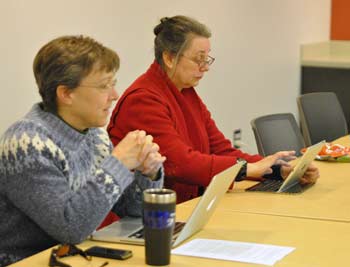
From left: Ann Arbor city councilmembers Margie Teall and Sabra Briere at the March 15 meeting of the council’s public art committee.
Polich suggested that if an outside entity had a contract with the city to administer the public art program, that entity could raise money then gift it back to the city. That arrangement could be specified in the contract. Steve Kunselman described it as the “privatization” of public art administration, and he didn’t think it needed to be laid out in detail in the ordinance.
Crawford indicated that there might be more flexibility if the city contracts with an organization, rather than directly with an individual.
Taylor advocated for letting city administrator Steve Powers work out the details. For his part, Taylor wanted to recommend that the city needs a full-time public art administrator, and that there should be a fundraising element involved. He didn’t care how that happened. After two years, if the work isn’t getting done in a satisfactory way, the city can revisit the arrangement and try something else, he said.
Teall also indicated her desire for a full-time administrator. Briere said she didn’t want to commit to that, and also isn’t willing to commit general fund dollars to pay for a public art administrator. She noted that the committee’s recommendations don’t deal with the issue of how to fund an administrator’s position. “We’ll look to wiser heads to help figure that out,” she said.
Revisions to Public Art Program: Open City Hall
When the committee first began meeting in late 2012, Sally Petersen had advocated surveying residents about how the city should deal with the public art program, or whether it should even continue. Lisa Wondrash, the city’s communications manager, attended a meeting in early January to describe A2 Open City Hall, an online system for soliciting feedback. Some councilmembers – in particular, Margie Teall – were reluctant to do any surveys, indicating that it would not be the best way to get feedback. The idea was never pursued.
On March 15, Sabra Briere again brought up the possibility of the A2 Open City Hall survey, noting that the committee had never reached a decision on it. Petersen said she felt that the window of opportunity had closed on that, since the committee had already nearly completed its work. Anecdotally, she said she’d heard that the committee was on the right track.
There was discussion about what types of questions might be asked if they were to use the A2 Open City Hall, and about the timing of such a survey. Petersen feared that if the survey were posted now, it would raise more questions and cause more confusion – because there were still a lot of unknowns. She suggested holding off on a decision until the next committee meeting, and other committee members agreed.
Revisions to Public Art Program: Next Steps
The council committee has set its next meeting for Thursday, March 28 at city hall starting at 11:30 a.m. Before then, the draft recommendations and revisions to the public art ordinance will be attached to the council’s March 18 meeting agenda as an item of communication. [.pdf of draft recommendations & ordinance revisions at start of March 15 meeting] [.pdf of draft recommendation & ordinance revisions reflecting changes at the March 15 meeting]
Because March 18 will be the last council meeting before the April 1 expiration of the moratorium on public art spending, it’s possible the council will take action to extend the moratorium. The committee doesn’t plan to make a formal recommendation to the council until April, possibly at its meeting on April 15.
Coleman Jewett Memorial
The agenda for the special March 7 AAPAC meeting included a resolution to accept the Coleman Jewett memorial as an official AAPAC project and to approve Sarah Gay as a volunteer project manager. Her duties would be to lead efforts for city council approval, donor relations and fundraising.
Jewett was a long-time local educator who died in January. After he retired, he made furniture that he sold at the Ann Arbor farmers market. A private donor has committed $5,000 to create a memorial at the market, in the form of a bronze replica of one of Jewett’s Adirondack chairs.
This project was discussed at AAPAC’s Feb. 27, 2013 meeting, but no action was taken then. John Kotarski had encouraged Gay to take on the project. At the Feb. 27 meeting Kotarski had said he didn’t see the need for AAPAC to get involved – saying he didn’t want the commission to be an “impediment.”
Gay is an arts administrator who grew up in Ann Arbor, but who doesn’t currently live here. She has attended some of the early meetings of the Ann Arbor city council committee that’s working on revisions to the city’s public art program.
During the discussion on March 7, Kotarski raised the same concerns about AAPAC’s involvement, saying it might simplify things if Gay worked directly with Sarah DeWitt, the city’s market manager.
DeWitt, who attended the March 7 meeting, indicated that she would work with anyone who was designated to manage this project. The farmers market is part of the city’s parks system, so the final donation would need to be made to the parks system and likely be vetted through the park advisory commission. But city staff cannot be involved in soliciting the funds. DeWitt said she could work with Gay or anyone else to determine the best location for the memorial, as well as other issues related to installing the memorial.
Marsha Chamberlin reported that she’s received estimates indicating it would cost about $25,000 for the bronzing, and perhaps a total of $50,000 for all aspects of the project. She felt it was important to define the project clearly, set a fundraising goal, and challenge the community to meet it. There was additional discussion about the logistics of handling the funding, such as whether donations would be made to a pass-through account managed by the Ann Arbor Area Community Foundation, on behalf of the city. There was a consensus that those details would need input from the city’s finance staff.
Both the parks & recreation unit as well as AAPAC have policies for accepting donations and gifts. From AAPAC’s guidelines:
C. Donations and Supplemental Sources of Funding
If supplemental sources of funding are used for public art projects, including grants, private donations, land, and in-kind services, AAPAC will identify the private interests or other restrictions associated with such funding and review the development of the public art projects for which the funding is used to ensure compliance with donor intent and other restrictions. [.pdf of complete AAPAC guidelines]
Kotarski reported that the private donor who pledged $5,000 for the project has stipulated that the memorial must be a bronze replica of one of Jewett’s actual Adirondack chairs. So in a sense, Jewett is the artist, Kotarski said – noting that it wouldn’t be a stylized work by another artist. He said that mayor John Hieftje had told him the $5,000 donation would be withdrawn if the donor’s stipulation wasn’t met.
Kotarski also lobbied for Gay to operate with independence from AAPAC. She should be able to make decisions related to the project and should not have to come to AAPAC for approval, he said. It’s a matter of control. “The less control we have and the more she has, the better,” Kotarski said. “She doesn’t want to fail.”
Chamberlin replied that based on her 35 years of experience in arts administration, “you don’t just turn someone loose on a project, no matter how good they are.” [Chamberlin recently retired as president of the Ann Arbor Art Center.] AAPAC should have input and approve things like the solicitation materials, she said. Another factor is the fact that Gay doesn’t live in the community at this point, so it’s important to have AAPAC involved.
Connie Brown supported handling the project like any other AAPAC project, with a task force that would work with Gay and make recommendations to the full commission. Craig Hupy – the city’s public services area administrator who also attended AAPAC’s March 7 meeting – said he didn’t want to cast aspersions on Gay, but he recommended that AAPAC stay involved, since they would, in a way, be putting their reputation on the line.
DeWitt also encouraged AAPAC to describe the memorial for Jewett in terms of his contributions to the community “writ large,” not only as a vendor at the farmers market. There are a lot of longtime vendors who have passed away, she said, and unless AAPAC envisioned bronzed heads of lettuce in the future, it’s important to keep the Jewett’s broader impact as part of these discussions.
Outcome: Commissioners voted unanimously to accept the Jewett memorial as an AAPAC project, and to designate Sarah Gay as the volunteer project manager.
East Stadium Artist Honorarium
On the agenda was an item to increase the honorariums for artists who have been selected as finalists for a $400,000 project at the East Stadium bridge. A task force has selected four artists as finalists, who have been invited to an April 1 site visit/open house. The finalists are: Volkan Alkanoglu, based in Atlanta, Georgia; Sheila Klein of Bow, Washington; Rebar Group of San Francisco; and Catherine Widgery of Cambridge, Mass.
The proposal was to increase the previous $2,000 honorarium to $3,000 for each artist. Bob Miller, a commissioner who serves on the task force, said task force members felt the compensation should be increased because artists were being asked to make two site visits and a proposal. In addition to Miller, members of the task force/selection panel are Wiltrud Simbuerger, Nancy Leff, David Huntoon and Joss Kiely.
John Kotarski supported the increase, but wondered how the task force had arrived at this new amount. Miller replied that one of the finalists had suggested the increase, and that it seemed reasonable based on the cost of airfare and other expenses. It’s still not much, Miller said, but it’s something.
Kotarski asked if the task force had compared the honorarium to projects in other cities. No, Miller replied. Aaron Seagraves, the city’s public art administrator, indicated that the $3,000 amount seems to be in line with what other communities offer, on average.
The overall project budget will not be increased. It now breaks down as follows:
- Artist contract: $360,000
- Artist honorarium ($3,000 each): $12,000
- Dedication: $4,000
- Signage: $3,000
- Walk through and other event expenses: $1,500
- Project management: $6,500
- Other admin costs: $1,000
- Contingency $12,000
Outcome: Commissioners unanimously voted to increase the East Stadium bridge honorarium to $3,000 per artist.
Community Canoe Art
Marsha Chamberlin gave an update on a canoe art project she’s working on with other organizations. It’s a project she got involved with before she retired as president of the Ann Arbor Art Center – not in her capacity as an AAPAC member, she said. [.pdf of canoe project memo]
The project will use old aluminum canoes that the city of Ann Arbor is getting rid of from the Argo canoe livery. There will be two components: (1) artists will be selected to create about a dozen original, permanent works (lasting more than five years); and (2) school groups or business teams will create another dozen or so works using the canoes.
According to the project memo, Cheryl Saam – facilities supervisor for the city’s canoe liveries – will oversee fundraising and work with a graphic designer to create a logo. [It's unclear how her role in fundraising will be defined, however, in light of discussions at the council's public art committee meeting that indicated city employees can't directly solicit donations for this kind of project.]
Partners in the project include the Ann Arbor Area Convention & Visitors Bureau (CVB), the Main Street Area Association (MSAA), the Arts Alliance, and the Huron River Watershed Council. The CVB will handle publicity, and the MSAA will deal with the logistics of placing the completed artwork at locations throughout the downtown, Chamberlin said.
The request to AAPAC is to help with advocacy and public engagement for the project, Chamberlin said, and to coordinate the kickoff to coincide with the dedication of artwork at the Argo Cascades. The canoe project is anticipated to be on public display between August and November of 2014.
Chamberlin said she’s talked with the Ann Arbor Area Community Foundation about setting up a pass-through account to accept donations. The goal is to raise about $100,000 for the project.
John Kotarski wondered why this project is being handled differently from the Coleman Jewett memorial. He felt that the Jewett memorial could also be an independent project like this canoe art, with minimal involvement from AAPAC.
He also said it was “challenging” for Chamberlin to talk to commissioners about this project while she was chair of AAPAC. When she used the word “we,” he said, it was difficult to know if she was speaking on behalf of AAPAC or for the project organizers.
Chamberlin replied that she was bringing this project forward just like any other similar effort. She saw it as analogous with the Detroit Institute of Arts’ Inside|Out program, which will be installing replicas of artwork in downtown Ann Arbor later this month. The project didn’t require AAPAC approval, she said, but the commission got involved and supported it.
Kotarski said he’s prefer that projects like this – the Jewett memorial, the DIA partnership, and the canoe project – not have to go through the AAPAC process of forming a task force and issuing requests for proposals. He wanted to streamline the process as much as possible. In terms of the canoe project, he didn’t think that AAPAC could add anything other than an “Atta boy!”
Chamberlin responded, saying it’s important for the canoe project to involve as many entities as possible, including AAPAC. It would require no financial commitment from AAPAC, although some staff time would be involved. It’s also possible that AAPAC might be approached in the future with a funding request, assuming the city’s public art program continues.
Outcome: Commissioners voted unanimously to collaborate on the community canoe art project, with no financial commitment at this time.
Annual Art Plan
Also on the agenda for the March 7 special meeting was discussion of AAPAC’s annual art plan. The city’s public art ordinance stipulates that a public art annual plan is due to the city council on April 1. This year, it would cover activities that AAPAC intends to pursue in fiscal year 2014, which runs from July 1, 2013 through June 30, 2014.
Aaron Seagraves, the city’s public art administrator, is developing a draft and was seeking input from commissioners at the meeting to shape the plan. His goal is to present a draft for their approval at AAPAC’s March 27 meeting.
This item has been discussed at previous meetings. At AAPAC’s meeting on Feb. 27, 2013, Deb Gosselin – who handles the city’s capital improvements plan (CIP) – talked with commissioners about that process, and how it might coordinate with AAPAC’s annual plan.
The CIP has been important to AAPAC because funding for the Percent for Art program has come from the city’s capital projects. Under the city’s Percent of Art program, 1% of each capital project, up to a cap of $250,000 per project, being set aside for public art. And even though it now appears that the Percent for Art funding approach could be eliminated, the goal will still likely be to start planning the public art component of a project as early as possible, as part of the project’s design, rather than as an add-on.
Seagraves had identified 30 projects in the CIP as having longer-term potential. [.pdf of long-term capital projects for possible public art] He had also identified a smaller list of 12 projects that AAPAC might consider for inclusion in its annual plan for fiscal 2014. [.pdf of FY 2014 CIP projects for possible public art] Those near-term CIP projects include the replacement of street lights along Main Street, the creation of a park at 721 N. Main, and renovations at the wastewater treatment plant, among others.
On March 7, Marsha Chamberlin noted that the process for developing this year’s annual plan has been met with frustration by some commissioners. Despite the public art program’s uncertain future, she said it’s important to have priorities for the coming year – even though the funding mechanism for public art might be changed.
John Kotarski referenced an email he’d sent on March 2 to commissioners and Seagraves, responding to a request from Seagraves to prioritize possible projects for the annual plan. [.pdf of Kotarski's email] Kotarski pointed out that AAPAC had embarked last year on a “quadrant” approach to developing public art projects.
By way of background, the approach uses four quadrants of Ann Arbor that are designated in the city master plan’s “land use elements” section: west, central, south and northeast. [.pdf map of quadrants] Two or more of the nine AAPAC members were to be responsible for each quadrant, charged with soliciting input from residents in selecting public art.
In his email, Kotarski raised concerns that now the quadrant approach, as envisioned, isn’t being used to prioritize projects for the annual plan. He cited several other concerns as well. An excerpt from his email:
We also have no standards (criteria) by which we are measuring art or locations. We have no way of measuring our process against best practices of successful communities elsewhere. All of you know that this has been a concern of mine for some time and it relates to art selection task forces as well. We were just informed that we should additionally consider prioritizing CIP projects. I am not certain that we share an understanding of what our duty is as a Commission much less an understanding of how we are to prioritize this list. I doubt if anyone can randomly select five locations on the list and offer the advantages and disadvantages for public art to be placed there.
For the time being, I propose we tell the administration that we want public art at every bus stop and ask the AATA to prioritize by ridership. That we want public art at every park and playground and to ask the Parks to prioritize by use. That we want public art in the downtown business district and ask the DDA to prioritize by their master plan. That we want public art at every major transportation artery into the city and let the Roads prioritize by usage. And that we want public art at every new CIP project and let the city staff prioritize. We are not organized well enough to do any better.
Several Commissioner have expressed to me that we have great ideas but lack follow through. My read of the quadrant meetings are that fewer than 10 residents showed up collectively and some of those were not from the quadrant in which the meeting was held. How can we remotely suggest that these 10 residents are the basis for our decisions? We were to assemble task forces for each quadrant that would focus on the pubic art opportunities and needs of their quadrant. That was not done.
We do not know how other cities do this. We do not know what residents want. We do not know how to evaluate public art or public art locations. I for one do not know how our proposed new leaders plan to change this. We do not even know what our new charge will be from the City Council.
We have over 40% of our Commission vacant, we lack the staff that everyone agrees we need, and we do not have a clear consensus among ourselves about what our job is. The adage “when you find yourself in a hole, stop digging” comes to mind. I know we have a deadline coming up, but to me this document does not serve to simplify the decision-making process but rather confuses it.
Some think we are a gatekeeper for public art in the city, yet I believe many on the City Council think differently. Many on City Council want us to grow public art from outside a taxpayer base and empower other groups to work independently. They want us to simplify and streamline the process. We at the least need that clarified before we proceed to recommend a public art plan.
Connie Brown said she was one of the commissioners who’s been “grouchy” about this annual plan process. AAPAC had put a process in place – using the quadrant approach – to get public input. But then the city council had put a public art millage on the Nov. 6, 2012 ballot, and that proposal had been defeated. The council then had voted to put the public art spending on hold, she noted.
She wondered if it would be appropriate to set broad goals – like choosing projects in underserved, highly visible areas – as an interim measure, until the city council decides the fate of the public art program.
Craig Hupy, the city’s public services area administrator, reminded commissioners that under the existing public art ordinance, AAPAC has a charge to produce an annual plan. He said he wouldn’t speculate about what the council might do regarding changes to the ordinance, or presume that councilmembers will take a certain direction.
Brown noted that AAPAC was told to stop its processes, and so they did. As soon as they have permission to start up again, they’ll be ready to prioritize and move forward. Until then, she said, “we’re throwing darts with our eyes closed.”
Seagraves asked that commissioners provide some general criteria for projects they’d like to see within the next fiscal year. After further discussion, the group reached consensus on the following attributes for public art projects in FY 2014: projects that are in highly visible, highly-used locations currently underserved in terms of public art, and that are distributed throughout the four quadrants of the city. Seagraves plans to take those priorities and draft an annual plan for AAPAC to consider at its March 27 meeting.
Outcome: This was not a voting item.
Officer Elections, Vacancies
The last order of business on March 7 was officer elections. Marsha Chamberlin, who has served as AAPAC’s chair since April of 2011, announced that two commissioners – Bob Miller and Malverne Winborne, AAPAC’s vice chair – were interested in the position of chair. Winborne did not attend the March 7 meeting.
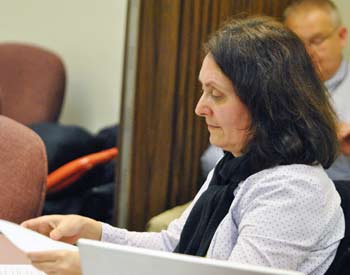
Wiltrud Simbuerger is planning to resign from the Ann Arbor public art commission, though she has not yet announced a date for her departure.
AAPAC’s bylaws call for the commission to hold officer elections for chair and vice chair in January. But elections were pushed back at both the Jan. 23, 2013 and Feb. 27, 2013 meetings because attendance was low. On Feb. 27, Chamberlin indicated that commissioners would receive ballots in the mail, with the outcome to be reported at the March 27 meeting. However, the election was on the March 7 special meeting agenda and took place then, with five of the six commissioners present.
John Kotarski said he felt compelled to abstain. Soon, the commission will be at only 40% capacity, he said – a reference to the fact that there are three vacancies on the nine-member commission, with an additional resignation expected by Wiltrud Simbuerger in the near future. He said there is no compelling reason to vote now, and it’s a mistake to choose leadership when there will soon be new members.
Earlier in the meeting, Chamberlin had reported that two nominations for AAPAC had been brought forward by mayor John Hieftje at the city council’s March 4 meeting: Nick Zagar, an artist and commercial real estate agent who serves on the Ann Arbor Art Center board; and Ashlee Arder, programs coordinator at ArtServe Michigan. Zagar is being nominated to replace Theresa Reid, for a term ending Dec. 31, 2015. Arder is replacing Cathy Gendron for a term ending Jan. 20, 2016. The nominations are on the council’s March 18 agenda for confirmation.
At AAPAC’s March 7 meeting, Chamberlin responded to Kotarski’s concerns by saying that AAPAC has a legal obligation to hold elections. Kotarski disputed that, and indicated that Chamberlin simply might not want to continue serving as chair.
Other members proceeded to vote.
Outcome: Bob Miller was elected chair. Malverne Winborne will continue to serve as vice chair.
Commissioners present: Connie Brown, Marsha Chamberlin, John Kotarski, Bob Miller, Wiltrud Simbuerger. Also Aaron Seagraves, the city’s public art administrator.
Absent: Malverne Winborne.
Next regular meeting: Wednesday, March 27, 2013 at 4:30 p.m. in the fourth floor conference room at city hall, 301 E. Huron St. [Check Chronicle events listing to confirm date]
The Chronicle relies in part on regular voluntary subscriptions to support our artful coverage of publicly-funded programs like the Percent for Art, which is overseen by the Ann Arbor public art commission. Click this link for details: Subscribe to The Chronicle.




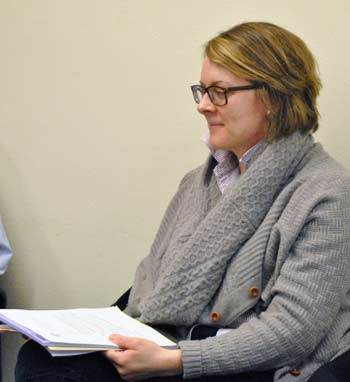
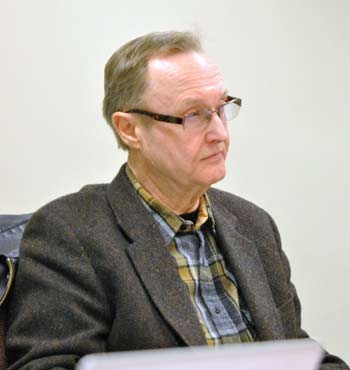

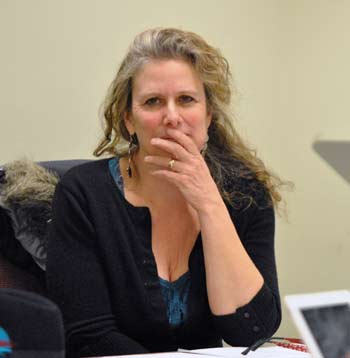
So this anonymous donor is only giving 10% towards the cost of the chair memorial, and will withdraw it if their conditions are not met. Why doesn’t anyone have the courage to say “thanks but no thanks”? Is it common for a 10% contribution to drive an entire project?
The five-member city council committee working to develop recommendations for the city’s public art program deserves our gratitude. They took on the thankless task of trying to understand what voters meant when they rejected the public arts millage. The arts millage, of course, was offered as a means of curing the defects in the percent for art mechanism that, among other things, diverted restricted funds for public art.
I hope Council will learn from the failed arts millage ballot proposal to use more care in crafting ballot language. For example, the Council has made a commitment to allow voters to vote whether to support a new train station. That ballot proposal needs to be clear enough so whether it is approved or rejected, the Council will have clear guidance on how to proceed. I can imagine a poorly drafted ballot proposal that would allow voters to reject the Fuller Road site for the station but leave unclear whether voters support building a new station at a different location.
The One Per Cent For Art Ordinance is a bad piece of legislation and needs to be abolished.
It is also questionable whether it is even legal.
i cannot believe that $400,000 is being spent on Art for the Stadium bridges. Just because the money was siphoned off of the project and exists is no reason to spend it. And of course it is going once again to out-of-state artists. Sure, the bridge is ugly, but still… as the saying goes, “you can’t polish a turd.” Not even with $400,000 worth of polish. What ever happened to saving?
I wish there was more attention being paid to the halls of Old City Hall. There is nowhere to sit and a bench would be great opposite the Kamrowski murals so that they could be viewed in a relaxing way (some of us need that!). The walls of the halls are very blank and uninviting but are heavily used by the public. This would be a good time to take stock of public spaces that need some public amenities.